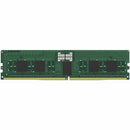Description
The Kingston RAM Module is engineered for enterprise servers and motherboards, delivering robust performance, reliability, and scalability for demanding workloads. With 16 GB of high-speed DDR5 memory, this module accelerates data access, enhances multitasking, and helps keep critical applications responsive even under heavy load. Built to meet the needs of data centers, virtualization hosts, database servers, and professional workstations, Kingston's server-grade RAM combines advanced memory technology with rigorous testing to ensure consistent operation across a wide range of configurations.
- Superior DDR5 performance for servers: This Kingston RAM Module leverages DDR5 technology to deliver higher data rates, improved bandwidth, and faster access to memory-resident data. The result is smoother operation of multiple concurrent workloads—virtual machines, containers, databases, analytics, and media processing—without bottlenecks. DDR5 introduces features like higher burst lengths and improved prefetch efficiency, enabling faster memory access for demanding enterprise applications. This translates to shorter data retrieval times, snappier response under load, and better overall system throughput.
- Massive capacity to power modern workloads: 16 GB of memory provides headroom for larger databases, more virtual machines, and memory-intensive applications. It reduces paging to disk, accelerates cold boot tasks, speeds up in-memory caches, and supports large-scale analytics and machine learning workloads in a single server or multi-node environment. For enterprises running virtualization hosts, this capacity enables more virtual machines per host and faster live migrations with less memory pressure, ensuring service levels remain stable during peak operations.
- Reliability you can count on: Kingston's server-grade RAM is designed and tested for 24/7 operation in data centers and enterprise environments. Components are selected for durability, and the module undergoes rigorous validation against a breadth of motherboard and server platforms. The result is predictable performance, stable operation, and reduced risk of memory errors that can disrupt critical services, even under sustained load, high concurrency, or demanding virtualization scenarios.
- Efficiency and thermal management: DDR5 memory uses improved power efficiency per bit and advanced thermal characteristics, helping to reduce overall energy consumption in dense server deployments. Lower idle power on memory chips, combined with improved heat dissipation, supports higher memory densities within the same cooling envelope and can contribute to lower total cost of ownership in round-the-clock operations. This efficiency also translates to cooler enclosures and more reliable long-term performance in high-density racks.
- Easy installation and broad ecosystem support: The Kingston RAM Module is designed for straightforward installation in standard server DIMM slots and commonly used server platforms. It is compatible with a wide range of motherboards and BIOS configurations, and Kingston's memory is tested to minimize compatibility issues and post-installation troubleshooting. Upgrading memory is a practical, cost-effective way to extend server life, boost performance, and prepare for future growth in virtualization, databases, and mission-critical workloads.
Technical Details of Kingston RAM Module
- Memory Type: DDR5
- Capacity: 16GB
- Form Factor: Server-grade DIMM
- Voltage: DDR5 standard values vary by SKU; exact voltage should be confirmed on the product specification for the specific model
- ECC: Availability varies by SKU; verify the exact model to confirm error detection features
- Certification: Tested for compatibility with common enterprise server platforms and Motherboard QVLs
How to Install Kingston RAM Module
- Power down the server and unplug the power cables. Ground yourself to avoid static discharge before handling memory modules.
- Open the server chassis and locate the memory banks recommended for upgrades in your motherboard or server manual. Ensure you have the correct type (UDIMM, RDIMM/LDIMM as applicable) for your platform.
- Hold the Kingston RAM Module by the edges and avoid touching the gold contact pins or memory chips. Align the notch in the module with the key in the memory slot.
- Insert the module firmly into the slot until the latches click into place, ensuring a secure, level seating without forcing the module.
- If upgrading more than one module, populate the slots in the configuration recommended by the motherboard or server vendor to optimize multi-channel memory performance.
- Reconnect power, boot the system, and enter the BIOS/UEFI to verify memory is detected at the correct capacity and speed. Apply any recommended memory profiles or BIOS updates from the vendor.
- Run memory diagnostics or a server benchmarking tool to validate stability and performance after installation. If any issues arise, re-seat modules or consult the hardware vendor’s support resources for guidance.
Frequently asked questions
- Q: Is Kingston RAM Module compatible with my server or motherboard? Kingston RAM Module is designed for servers and motherboards and is built to meet industry standards. To confirm compatibility, compare the exact SKU against the vendor's compatibility list (QVL) for your server model or motherboard and verify speed, ECC support, and module type in the official product specification.
- Q: What advantages does DDR5 memory provide for servers? DDR5 offers higher data rates, improved bandwidth, and better power efficiency per bit compared to previous generations, which translates to improved performance in multi-tenant environments, databases, virtualization, and real-time analytics while helping maintain cooler operation in dense data centers.
- Q: Do I need ECC with Kingston RAM Module? The need for ECC depends on the SKU and server requirements. Many server configurations benefit from ECC-enabled memory to detect and correct errors, increasing reliability for mission-critical workloads. Check the exact model's specifications to confirm whether ECC is included.
- Q: How many memory channels should I use for best performance? For servers, populate memory in the recommended channel configurations provided by the motherboard or server vendor to maximize memory bandwidth and multi-channel efficiency. Refer to your system’s memory population guidelines for precise guidance.
- Q: What should I do if the RAM is not detected after installation? Ensure the module is firmly seated in the slot, verify it is compatible with your motherboard or server model, review BIOS/UEFI memory settings, and test with a single module before adding additional modules. If issues persist, consult your hardware vendor’s support resources.
Customer reviews
Showing - Of Reviews


